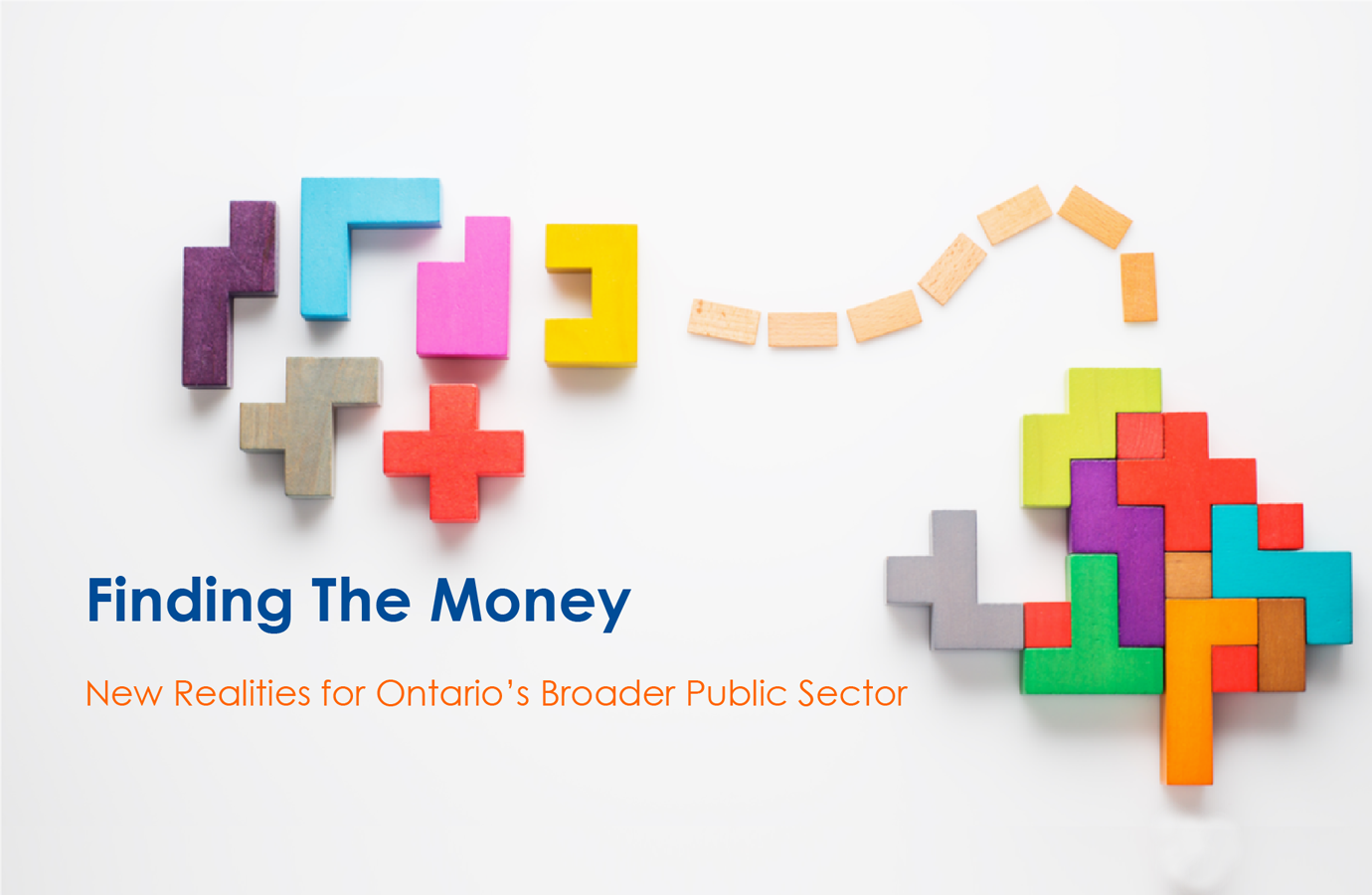New Realities for Ontario’s Broader Public Sector
At Optimus SBR, we regularly keep an eye on public sector developments for our clients. With a new Ontario government, there has been no shortage of new developments, so we have put together this briefing for our Ontario Transfer Payment Agency (TPA) and Broader Public Sector (BPS) clients.
Ontario’s New Government, 100 Days In
Ontario’s new Progressive Conservative government was sworn in a little over one hundred days ago, and has moved quickly ever since. While it is still early in the mandate, key messages and areas of focus are emerging:
- Finding the Money – During the campaign, the PCs promised to find $6 billion in savings from the provincial government, roughly 4% of the total stated budget at the time. While the fall economic statement set for November 15th will say more, indications to date are that, across government, efficiency targets in this range are not only real, but likely even greater in areas that are seen as outside of government’s core functions.
- Consolidating Transfer Payment Agencies –TPAs, of course, represent a wide variety of organizations – from regulatory agencies and hospitals to forestry authorities and community organizations, providing all kinds of programs and services. Much of the government’s early attention has been focused on the thousands of such organizations the government relies on to carry out policy and deliver services.
- Consolidation is coming – in all sectors. Senior civil servants and appointees are already picking up this messaging in public and private discussions.
- More Data! – Senior government officials want more data, particularly about outcomes for Ontarians and the bottom line, to clarify what value TPAs provide to government and more importantly the people of Ontario.
What can TPA and BPS leaders do as the government focuses on the finding the money, consolidation, and data? We provide some answers – mantras, really – below.
What Leaders Can Do to Prepare
1) It’s Not About You, It’s About What You Do and Who You Do it For
Individual agencies, health and social service providers, service delivery organizations and other TPAs often play a niche role in a broader system. Leaders will need to ask themselves:
- Are we demonstrating unique value?
- Are we delivering programs, services or functions that are more valuable than what government could get from other agencies or the not-for-profit or private sector?
Organizations must be able to answer these questions, because government will certainly be asking them. Imagine central agencies and ministries mapping, mixing, and matching various organizations’ mandates, core functions, programs, and services – yours included – to figure out what makes sense for the system. They will be stepping back and asking:
- What are people getting out of the system?
- What does government need to do here, if anything? Does it need to do things or just fund them?
- Do we need all of these organizations? Does the way these organizations are set up actually help us achieve our goals?
In other words: consolidation discussions are not going to be about you and your organization – they are going to be about whether what you do needs to be done or funded by government, whether you are a high value provider, and if so, what capabilities you have to ensure government is only as big as it needs to be and minimizes its impact on taxpayers’ wallets.
The question of whether you demonstrate unique value also applies to organizations in the regulatory space. In his book The Regulatory Craft, Harvard’s Malcolm Sparrow’s mantra for regulators is “…to pick important problems and fix them.”1 The corollary is that if you are doing things that do not fix real problems, then you likely need to stop doing them and get out of the way. For organizations charged with fixing problems in a regulatory context, the corresponding questions will be:
- Are you focusing on real problems that are of significant public interest?
- Are you uniquely able to fix those problems on your own? Is that apparent in the outcomes you are mandated to monitor and improve?
- How are you and your partners striving to fix problems and hold yourself accountable for outcomes, rather than – as sometimes happens – diffusing accountability?
2) Prioritize: What is Yours to Do?
Citizens and government are demanding a system of partners that demonstrate collective accountability in every sector. To prepare for this type of discussion, you need to ask what the priorities are, starting with the system’s and ending with yours. At OPTIMUS | SBR, we use our Accountability Framework® System (AFS) to help clients do strategic planning. The AFS boils public sector organizations’ mandate and mission down to a single question: What is ours to do?
Right now, organizations will need to ask themselves some serious questions that are less often asked: Should what we do be done by government? Could someone else do it better? Do we need to deliver things differently or with other partners?
To answer these questions you will need to sort through system priorities and ask hard questions about whether you need to prune back programs and services that have accumulated over time:
- What system priorities can we play a high value role in advancing? What is ours to do for the system?
- Which priorities did we inherit, or were asked as an organization to take on because they “didn’t fit” anywhere else, even if they didn’t exactly match our mandate?
- Can we divest existing programs or services that no longer make sense?
- Which of our core programs and services simply must continue?
Once you’ve asked and answered these questions, you should then step back and ask, “How has our role changed? What does that mean for how we are organized internally? Do we have the right people for the job? Are we working with our partners the right way?”
3) Make Visible Changes and Have the Tough Conversations
This government has already made some tangible changes on matters large and small – getting rid of certain tax and license fee increases, for example – that signal its priorities to all Ontarians.
You and your Board should also identify visible changes that signal your organization is making life easier (when it should be) for stakeholders and asking hard operational questions like:
- Do funding, stakeholder contributions or user fees need to increase this year, or can they be kept flat (or better yet, reduced) if some hard decisions are taken this year?
- Are there aspects of your processes that irritate stakeholders or get in the way of you doing your work most effectively? Can a few of them be changed quickly?
- What can you do for stakeholders that says: “We get it. We’ll fix it.”?
These types of questions require tough conversations. And when fiscal constraints bite in a new environment, leadership must recognize that it is not immune from the pressures.
These conversations must happen, and not just because there are tough decisions to be made – for many TPAs, there are existential decisions to be made. And if, in the pursuit of savings, an organization closes up shop because its functions have gone to another and citizens – as clients, patients, advocates, business people, or taxpayers – are better off as a result, isn’t that what public sector leaders are after anyway?
An Optimistic Thought
Life moves pretty fast. If you don’t stop and look around once in a while, you could miss it.
– Ferris Bueller, Ferris Bueller’s Day Off
To some leaders, these mantras will sound dire. They’re not. But they do reflect the speed at which Ontario’s new government is moving and the urgency with which public sector leaders need to act. Public sector leaders who get the big picture, and can have the tough conversations to prioritize, fix problems, and make visible changes will find savings more easily than others and still find themselves with much to do. Right now, you have an opportunity to design your future, rather than have it designed for you.
Optimus SBR’s Public Sector Practice
We can help design your future with you. We know these are big questions, because we ask them every day when we work with our clients to define their mandate, chart the next 3-5 years, find a partner, or find savings. Give us a call, or send us a note.
Brad Ferguson, SVP, Industries and Government Practice
Brad.Ferguson@optimussbr.com
416.649.9184
David Lynch, Principal
David.Lynch@optimussbr.com
[1] Sparrow, Malcolm (2000). The Regulatory Craft. Washington DC: Brookings Institution Press, p. 9. Italics in original.

Optimus SBR Celebrates 6 Consecutive Wins as 2024 Best Workplaces™ in Professional Services
Our commitment to a people-first approach has been central to being recognized in 2024 for the sixth time as one of the Best Workplaces™ in Professional Services and the key to our overall success.

12 Best Practices to Increase Cross-Team Collaboration and Enhance Organizational Alignment
Enhancing cross-team collaboration drives innovation, optimizes resources, improves overall performance, and ensures every part of your organization works toward the same goals.

Enhancing Your Data Strategy for Success: The Power of Metadata
Metadata goes beyond just aiding in data retrieval. It ensures your data is secure, compliant and, most importantly, understood consistently by everyone in the organization.

Optimizing Language Translation Strategies: Beyond Compliance to Enhanced Operational Efficiency
The introduction of Quebec’s Bill 96 in Canada underscores the necessity for comprehensive translation strategies. Integrating machine translation technologies helps meet regulatory requirements while enhancing translation speed, cost efficiency, and operational effectiveness.

How to Manage Gen Z: 16 Strategies to Engage and Retain Young Talent
These practical strategies lead to a workplace that is better aligned with the values and expectations of Gen Z employees, ensuring that your efforts to attract and retain Gen Z talent are both successful and sustainable.

How to Measure the Success of Learning and Development: 12 Important Metrics to Evaluate
Quantifying the success of L&D training programs can be challenging. Learn about selecting and measuring the right metrics to determine whether your training efforts are truly making an impact.



